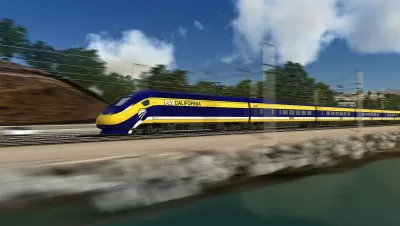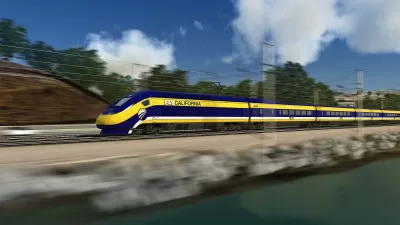Plaintiffs suing the state of California over a 2016 law that allowed the High-Speed Rail Authority to tap a $9.9 billion bond measure, passed by voters a decade ago to pay for construction on "usable segments," came up short for the second time.

"Sacramento County Superior Court Judge Richard Sueyoshi issued his ruling on Wednesday [Oct. 31] denying a motion by Hanford-area walnut farmer John Tos, the Kings County Board of Supervisors and other opponents to block the California High-Speed Rail Authority’s use of Proposition 1A bond funds for the project," reports Tim Sheehan of The Fresno Bee.
It’s the second time that litigation over the project’s compliance with Proposition 1A, a $9.9 billion bond measure approved by voters in 2008, has been decided in favor of the rail authority.
The latest case took a different approach, instead asking a judge to invalidate Assembly Bill 1889, a 2016 bill that deemed that Proposition 1A funds could be used for construction of a “usable segment” of the rail route that is “suitable and ready for high-speed train operation,” such as construction now underway on about 120 miles of the line in Madera, Fresno, Kings, Tulare and Kern counties.
"This is a big deal. It’s the last gasp of a suit that could have stopped the project cold," wrote Roger Ruddick on Oct. 30 for Streetsblog in an "open letter to the LA Times," asking why the paper failed to report on the tentative ruling on Oct. 25.
Other segments in the legislation included the San Francisco Peninsula where the bullet train would share tracks with the Caltrain commuter line on the route from San Jose to San Francisco. "AB 1889 clarifies that Caltrain’s electrification project is 'suitable and ready' for investment and that the investment in the Caltrain system is consistent with the Authority’s current business plan," states an Oct. 7, 2016 news release on the bill-signing. The project broke ground in July 2017, while construction in the Central Valley broke ground [pdf] on Jan. 6, 2015.
The plaintiffs, which also included "the town of Atherton along the San Francisco Peninsula, several Peninsula residents, former state senator and judge Quentin Kopp of San Francisco, and several nonprofit rail organizations: the California Rail Foundation, the Community Coalition on High-Speed Rail, and Transportation Solutions Defense and Education Fund (TRANSDEF)" charged that AB 1889 was unconstitutional, claiming that the voters needed to have a say before allowing the bond funds to be spent. But the judge ruled otherwise:
Sueyoshi said that “nothing in the documentation that was before the voters at the time of consideration of Proposition 1A clearly prohibits or contradicts the language of AB 1889,” and added that “it cannot be concluded that AB 1889 ‘clearly, positively and unmistakably’ violates voter intent” to render it unconstitutional.
Appeal and other lawsuits
Stuart Flashman, the plaintiff's attorney, indicated he needed to consult with his clients before deciding whether to pursue the case before a state appellate court.
Besides the Tos case, the rail authority still faces another lawsuit filed by Kings County under the California Environmental Quality Act challenging the adequacy of environmental documents used to justify the selection four years ago of a route for the train line from south of Fresno to northwest of Bakersfield.
The case was one of several filed over the route selection; all the others have since been settled.
One such lawsuit under CEQA was settled by the rail authority with the small town of Shafter in Kern County on Oct.25.
Related in Planetizen:
-
The California High-Speed Rail Authority's Board Took a 'Momentous' Step on Tuesday, December 15, 2016The California High-Speed Rail Authority voted on December 13 to approve two plans that would spend $3.2 billion in high-speed rail bond funds for continuing construction in the Central Valley and help pay for Caltrain commuter rail electrification.
-
The lawsuit by Kings County et.al. was a significant threat to California's $64 billion rail plan, based on the plan's ability to meet the terms promised in the 2008 proposition, such as travel time due to sharing tracks with Caltrain.
Hat tip to Headlines, Streetsblog California.
FULL STORY: Bullet-train foes lose another round in court fight against construction in the Valley

Maui's Vacation Rental Debate Turns Ugly
Verbal attacks, misinformation campaigns and fistfights plague a high-stakes debate to convert thousands of vacation rentals into long-term housing.

Planetizen Federal Action Tracker
A weekly monitor of how Trump’s orders and actions are impacting planners and planning in America.

San Francisco Suspends Traffic Calming Amidst Record Deaths
Citing “a challenging fiscal landscape,” the city will cease the program on the heels of 42 traffic deaths, including 24 pedestrians.

Defunct Pittsburgh Power Plant to Become Residential Tower
A decommissioned steam heat plant will be redeveloped into almost 100 affordable housing units.

Trump Prompts Restructuring of Transportation Research Board in “Unprecedented Overreach”
The TRB has eliminated more than half of its committees including those focused on climate, equity, and cities.

Amtrak Rolls Out New Orleans to Alabama “Mardi Gras” Train
The new service will operate morning and evening departures between Mobile and New Orleans.
Urban Design for Planners 1: Software Tools
This six-course series explores essential urban design concepts using open source software and equips planners with the tools they need to participate fully in the urban design process.
Planning for Universal Design
Learn the tools for implementing Universal Design in planning regulations.
Heyer Gruel & Associates PA
JM Goldson LLC
Custer County Colorado
City of Camden Redevelopment Agency
City of Astoria
Transportation Research & Education Center (TREC) at Portland State University
Jefferson Parish Government
Camden Redevelopment Agency
City of Claremont



























